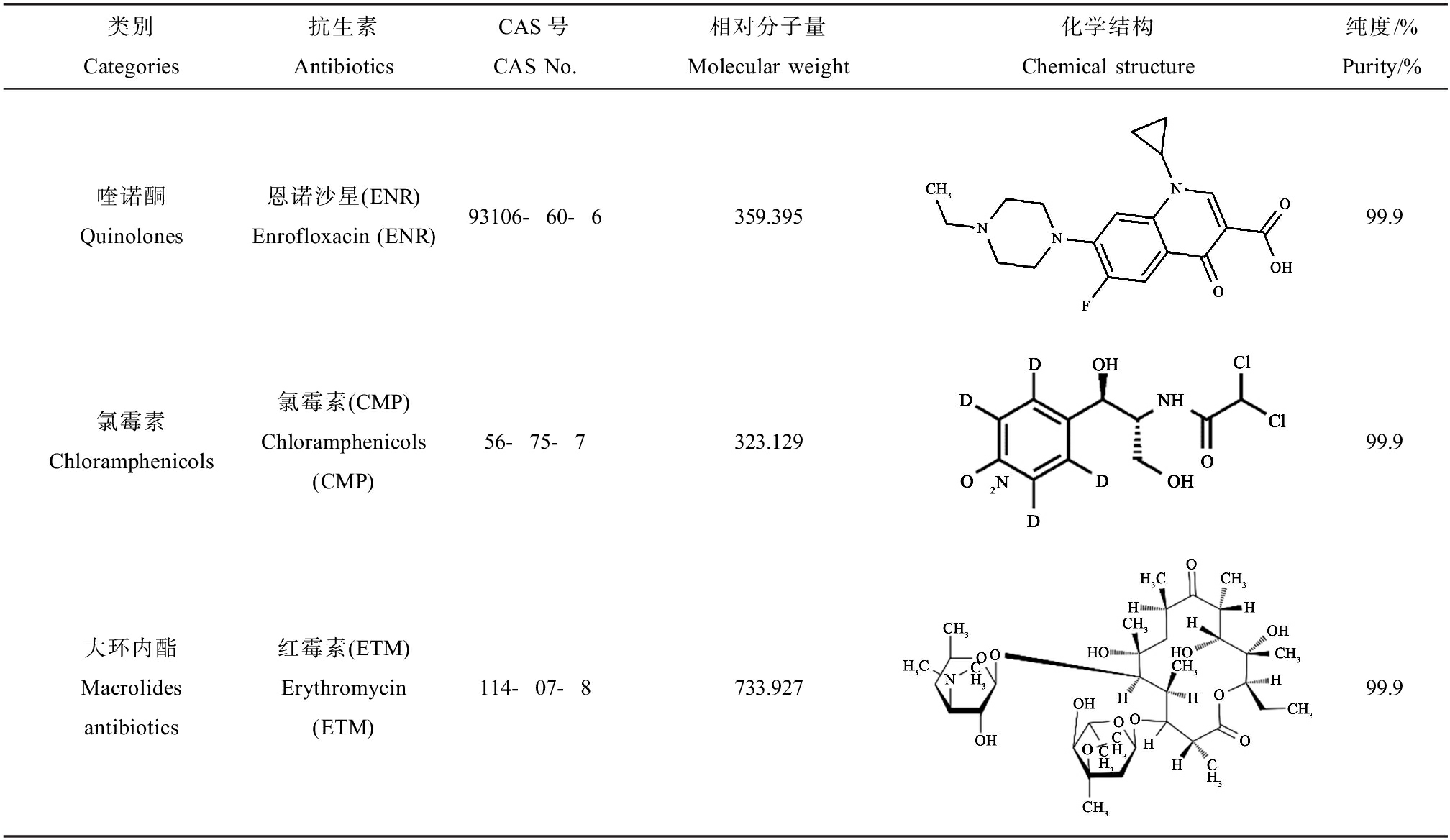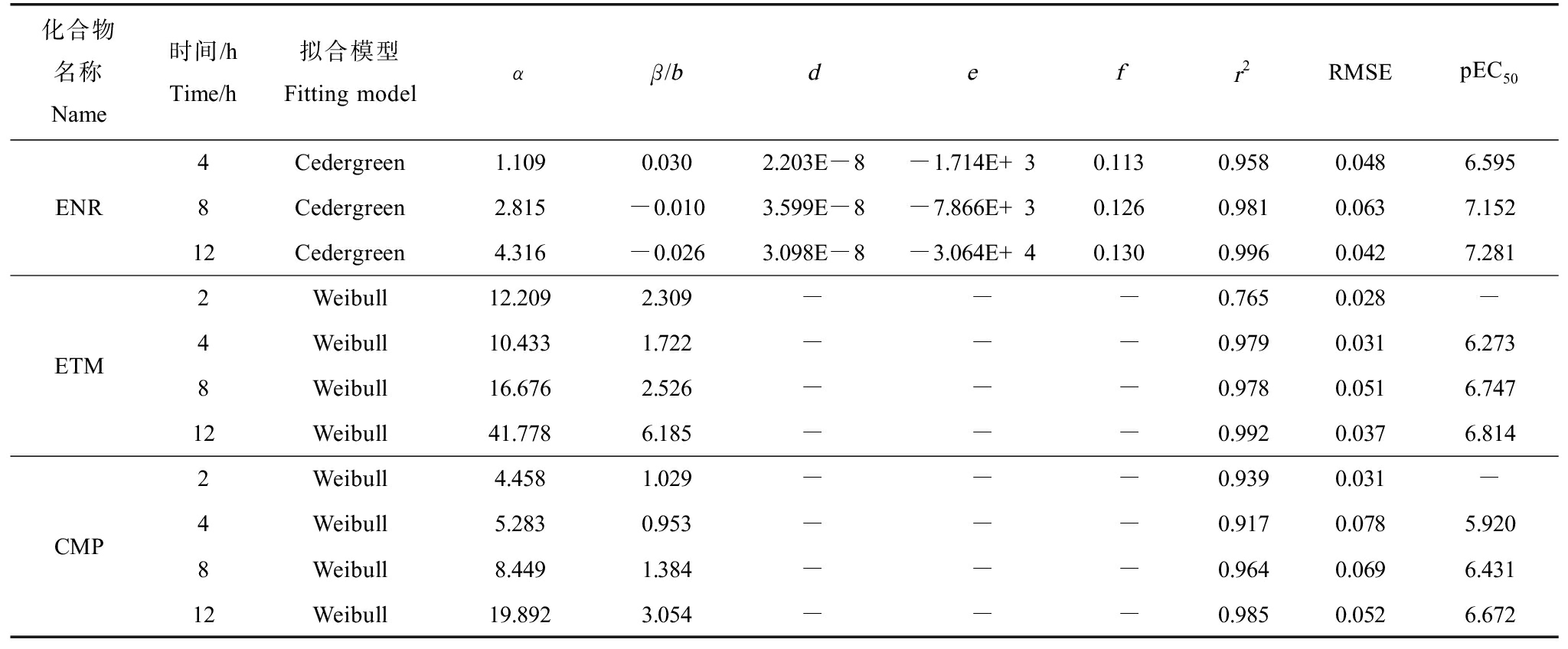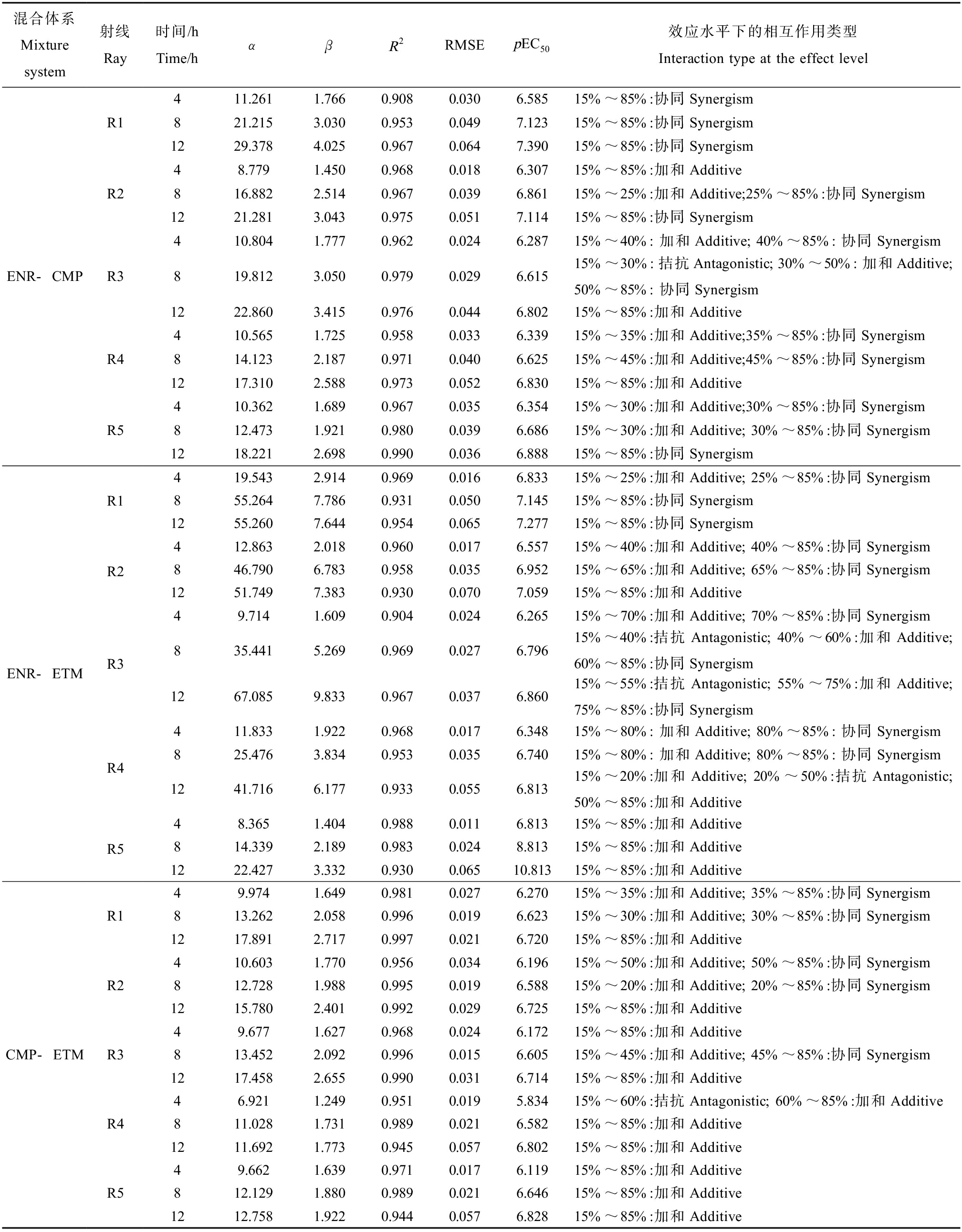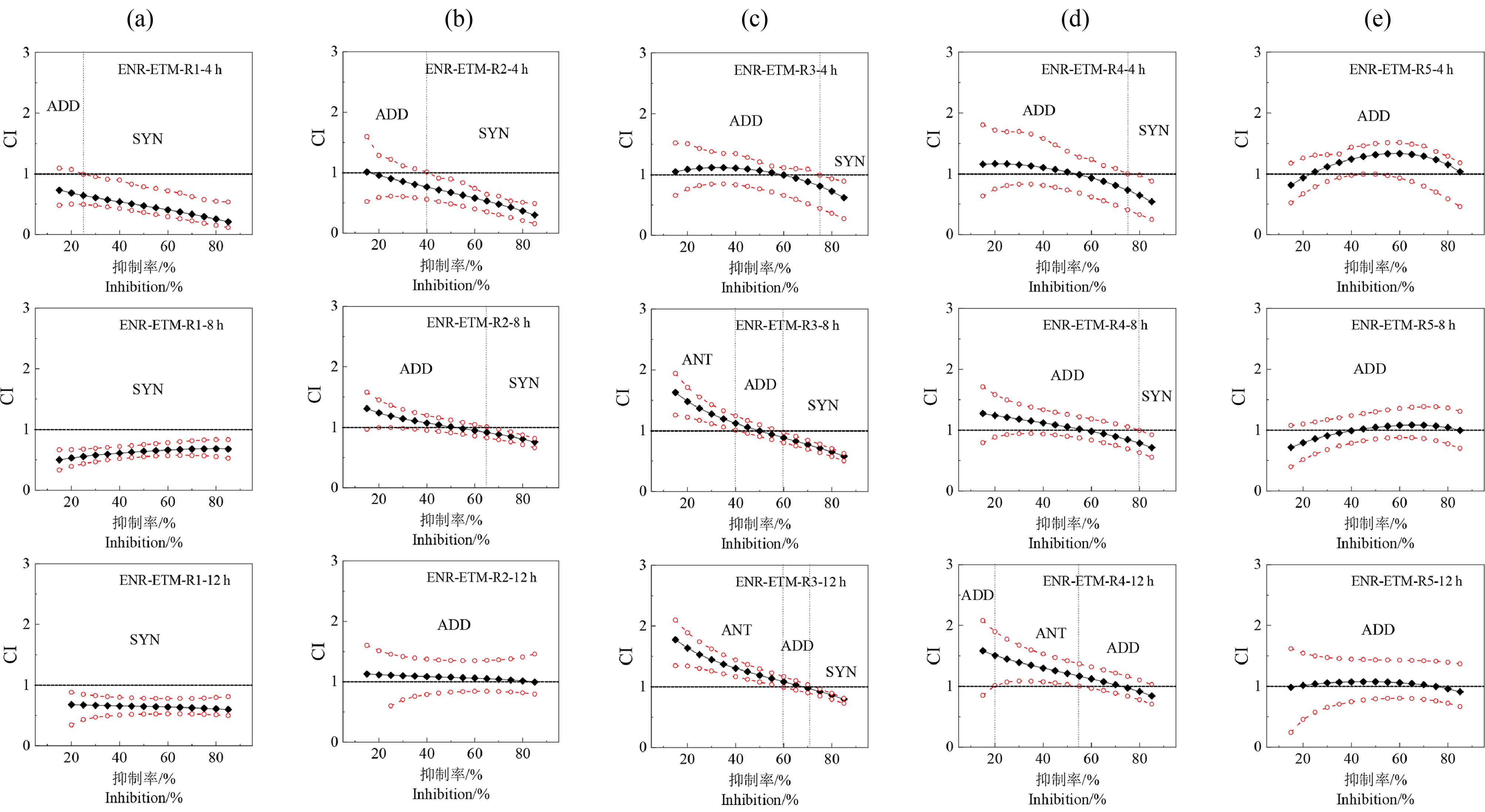抗生素是20世纪最重要的医学发现之一,随着经济社会的快速发展,抗生素在给人类带来健康及便利的同时也给环境带来极大的危害[1-2]。抗生素主要是由细菌、霉菌或其他微生物产生的次级代谢产物或人工合成的药物,在微量时就能抑制其他微生物生长,也能在较低浓度时有选择性地干扰细胞的代谢作用,妨碍生命活动或使停止生长,甚至死亡。2000年,美国地质勘探局对美国139条河流进行了调查,检测出了21种抗生素,暴露浓度为60~690 ng·L-1[3];2020年,Qin等[4]在我国广西桂林市会仙湿地的水体中检测出10种磺胺类抗生素,暴露浓度介于6.37~2 414 ng·L-1;在上海黄埔江沿岸分别检测出四环素类、氯霉素类、喹诺酮类、磺胺类和大环内酯类等22种抗生素,暴露浓度介于36.71~313.44 ng·L-1 [5]。
在现实生活中人们普遍认为“剂量决定毒性”。近年来研究表明,暴露时间也是影响污染物毒性大小的重要因素[6-7]。如:Xiong等[8]研究发现斜生栅藻暴露于磺胺类抗生素中2、4、7和11 d时,随暴露时间的延长毒性效应增大。Backhaus等[9]以费氏弧菌为指示生物,抗生素为研究对象,研究发现24 h长期毒性比30 min短期毒性高很多,如:氯霉素和四环素的毒性分别增加了1 135倍和825倍。Park和Choi[10]研究磺胺噻唑对大型溞的毒性作用时发现,48 h表现毒性是24 h的4倍。农琼媛等[11]研究也证实,土霉素、环丙沙星对羊角月牙藻的毒性作用,随暴露时间延长其毒性效应增大。
随着混合物毒性相互作用研究的不断深入,加上环境中抗生素污染物“混合-持久”的暴露特征,研究者已对抗生素进行了不同暴露时间的联合毒性研究[12-13]。如:丁婷婷等[12]研究3种氨基糖苷类抗生素对Q67三元混合毒性,并用浓度加和模型对5条具有不同浓度配比的混合物射线进行评估,其混合物联合毒性在不同暴露时间均呈加和作用;Zou等[13]研究磺胺类抗生素(SAs)与三甲氧苄氨嘧啶(TMP)对明亮发光杆菌混合毒性,发现急性混合毒性(0.15 min)相互作用测试体系中SAs-TMP呈现拮抗作用,而慢性混合毒性(24 h)相互作用测试体系中SAs-TMP呈现协同作用。然而,目前浓度加和(concentration addition, CA)和独立作用(independent action, IA)模型是广泛用于混合物毒性相互作用评估的2个模型;一般认为,CA模型适用于具有相似作用模式的混合物体系,IA模型则适用于具有相异作用模式的混合物体系[14-15]。然而,上述这2种评估模型也存在一定的不足[16]:(1)不能直观定量表征混合物的联合毒性的相互作用;(2)传统模型存在依赖组分作用模式,在现实环境中由于污染物的作用模式的不确定性,从而无法准确选择CA和IA模型进行预测。Chou[17]基于半数效应方程,提出了组合指数模型(combination index, CI),其不依赖于作用模式,能定量表征混合物相互作用的大小,具有坚实的理论基础。近年来,有研究者开始关注CI并用于评估混合物的毒性相互作用,González-Pleiter等[18]利用CI和加和模型及独立作用模型评估了5种抗生素组成的混合物对鱼腥藻和绿藻的联合毒性,认为CI能更准确预测朝向协同作用的实验误差。Chen等[19]研究了农药与Cd混合物对E. fetida的毒性相互作用,得出CI的预测结果比CA和IA更准确。Mo等[15]运用CI评估Cd2+-Ni2+和Cd2+-Cr6+混合物对2种藻的毒性相互作用,得出毒性相互作用与指示生物、混合物组分占比和效应区间有关。
本研究以使用量较大且在环境中同时检出的恩诺沙星、氯霉素和红霉素3种抗生素为研究对象[20-22],以淡水发光菌-青海弧菌Q67(Vibrio qinghaiensis sp.-Q67)为指示生物,采用直接均分射线法(equipartition ray, EquRay)[23]设计3种抗生素不同浓度配比的二元混合物,应用时间依赖微板毒性分析法(t-MTA)测定单个污染物及其二元混合物不同暴露时间的毒性,根据浓度-效应曲线分析混合物毒性效应随暴露时间的变化规律,并应用CI定量评估不同暴露时间下混合物的毒性作用,揭示不同类型的抗生素混合污染物毒性相互作用随暴露时间的变化规律,分析其对应的混合物联合毒性作用出现的频率,为不同类型的污染物混合评估提供理论依据。
1 材料与方法(Materials and methods)
1.1 材料与仪器
3种抗生素:恩诺沙星(enrofloxacin, ENR)、氯霉素(chloramphenicols, CMP)和红霉素(erythromycin, ETM)均购于美国CATO(CATO Research Chemicals Inc.)公司,其理化性质列于表1中。测试药品储备液用超纯水配制,并置于4 ℃冰箱中保存、备用。青海弧菌Q67(Vibrio qinghaiensis sp.-Q67)购自北京滨松光子技术股份有限公司,菌种培养过程参考文献[24-25]。Synergy 2 Multi-Mode多功能酶标仪(美国BioTek伯腾仪器有限公司),GZX-9240MBE电热鼓风干燥箱(上海博讯实业有限公司医疗设备厂,中国),YXQ-LS-70A内循环立式压力蒸汽灭菌器(上海博讯实业有限公司医疗设备厂,中国),HYQ-150震荡培养箱(上海一恒科学仪器有限公司,中国)。
表1 3种抗生素的基本信息
Table 1 Basic information of three antibiotics

类别Categories抗生素AntibioticsCAS号CAS No.相对分子量Molecular weight化学结构Chemical structure纯度/%Purity/%喹诺酮Quinolones恩诺沙星(ENR)Enrofloxacin (ENR)93106-60-6359.39599.9氯霉素Chloramphenicols氯霉素(CMP)Chloramphenicols (CMP)56-75-7323.12999.9大环内酯Macrolides antibiotics红霉素(ETM)Erythromycin (ETM)114-07-8733.92799.9
1.2 混合物设计
为了全面揭示二元混合物不同组分和不同空间浓度配比的混合物组分间的毒性相互作用,以12 h时的EC50作为参考浓度,采用直接均分射线法(EquRay)设计ENR、CMP和ETM 3种抗生素的3组二元混合体系,从大量的混合物中选择代表性的5条混合物射线(R1、R2、R3、R4和R5),根据每条混合物射线中各组分的浓度比(pi)(混合物混合比例见表2),每条射线设置12个具有不同浓度的混合物点。
表2 两组分在各射线中的浓度占比
Table 2 The percentage of concentration of the two ingredients in each ray

混合物体系Mixture system射线Ray组分-AIngredient-A组分-BIngredient-B浓度/(mol·L-1)Stock/(mol·L-1)ENR-CMPR10.3460.6541.04E-7~1.56E-9R20.1750.8251.86E-7~2.79E-9R30.0960.9042.91E-7~4.36E-9R40.0500.9504.32E-7~6.47E-9R50.0210.9796.29E-7~9.44E-9ENR-ETMR10.4320.5687.57E-8~1.14E-9R20.2330.7671.13E-7~1.70E-9R30.1320.8681.51E-7~2.27E-9R40.0710.9291.90E-7~2.86E-9R50.0290.9712.30E-7~3.45E-9CMP-ETMR10.8780.1227.15E-7~1.07E-8R20.7240.2585.70E-7~8.55E-9R30.5890.4114.64E-7~6.97E-9R40.4180.5823.84E-7~5.76E-9R50.2230.7773.84E-7~5.76E-9
注:组分-A为混合体系中前者,组分-B为混合体系中后者。
Note: Ingredient-A is the former in the mixed system and Ingredient-B is the latter in the mixed system.
1.3 时间毒性测试与数据拟合
抗生素及其混合物对Q67的时间毒性测定采用时间毒性微板分析法(t-MTA),具体操作方法参考文献[26]。加入菌液的微板置于恒温(22±1) ℃的生化培养箱中培养,暴露时间为0.25、2、4、8和12 h时取出并置于Synergy 2 Multi-Mode多功能酶标仪中测定其发光强度,并计算酶标仪中检测出抗生素及其混合物对发光菌在不同暴露时间的发光抑制率[27]。
为揭示不同暴露时间、不同浓度的抗生素及其混合物对发光菌的毒性变化规律,采用Weibull(式1)[28]和Cedergreen(式2)[29]对不同时间点的浓度-效应数据使用程序MixToxPred_CA IA中a1_CurveFit.m进行拟合,拟合的相关系数的平方(square of correlation coefficient,简称r2)最大和均方根误差(root mean square error, RMSE)最小者为最优[30]。用于描述实验毒性数据的非线性拟合函数公式如下:
y=1-exp(-exp(α+β×log10(x)))
(1)
(2)
式1(S型 浓度-效应曲线)中:α为位置参数,β为斜率或曲率参数。式2(J型 浓度-效应曲线)中:α表示下降部分曲线的斜率;b表示上升部分曲线的斜率;d表示未处理空白对应的响应/效应;e表示半数效应浓度(EC50);f表示化学品的刺激程度。
1.4 混合物的相互作用分析
1981年在半数效应方程研究的基础上,Chou[17]提出了不依赖组分作用模式的用于评估药物联合效应的组合指数方法(CI)。组合指数计算公式如下:
(3)
式中:CIx表示效应为x%时的CI值;ci是混合物中第i个化合物产生x%效应的浓度;ECx,i是第i个化合物单独产生x%效应的浓度;n是混合物组分数。CI=1、>1、<1表示混合物相互作用分别为加和、拮抗和协同作用,本文引入基于观测值的95%置信区间[31],其评价相互作用的标准为:置信区间包含了1时,为加和作用,置信区间下限>1时,为拮抗作用;置信区间上限<1时,为协同作用。
2 结果(Results)
2.1 单一抗生素对Q67的时间毒性
ENR、CMP和ETM在不同时间点(0.25、2、4、8和12 h)对青海弧菌Q67的浓度-效应数据通过非线性函数拟合的结果列于表3中,其浓度-效应曲线绘于图1(其浓度-效应无明显变化的效应曲线未进行拟合)。

图1 单一抗生素的抑制率-浓度-时间变化关系图
Fig. 1 The relationship of inhibition rate-concentration-time of a single antibiotic
表3 单一抗生素的拟合参数
Table 3 Fitting parameter of a single antibiotic

化合物名称Name时间/h Time/h拟合模型Fitting modelαβ/bdefr2RMSEpEC50ENR4Cedergreen1.1090.0302.203E-8-1.714E+30.1130.9580.0486.5958Cedergreen2.815-0.0103.599E-8-7.866E+30.1260.9810.0637.15212Cedergreen4.316-0.0263.098E-8-3.064E+40.1300.9960.0427.281ETM2Weibull12.2092.309---0.7650.028-4Weibull10.4331.722---0.9790.0316.2738Weibull16.6762.526---0.9780.0516.74712Weibull41.7786.185---0.9920.0376.814CMP2Weibull4.4581.029---0.9390.031-4Weibull5.2830.953---0.9170.0785.9208Weibull8.4491.384---0.9640.0696.43112Weibull19.8923.054---0.9850.0526.672
注:pEC50为半数效应浓度(EC50)取负对数值;-表示无数据。
Note: pEC50 is the negative logarithm of median effect concentration (EC50); - means no data.
由表3可知,拟合的相关系数平方(r2)在暴露时间为4、8和12 h时均在0.917以上,RMSE<0.078,Cedergreen函数和Weibull函数能较好地拟合ENR、ETM和CMP对Q67在不同暴露时间的浓度-效应数据。由图1可知,3种抗生素对Q67的浓度-效应曲线(CRCs)均是随暴露时间延长呈从下至上依次排列,表明这3种抗生素毒性均具有明显的时间依赖毒性。但不同抗生素对Q67的毒性随暴露时间的延长变化规律不同,如ENR暴露8~12 h时其CRC为J型曲线,引起Q67随暴露时间变化的毒性兴奋效应(Hormesis),且该曲线存在浓度约为4.02E-8 mol·L-1的交叉点;除0.25 h和2 h时抑制率随浓度变化不明显外,暴露8 h和12 h时其最大刺激点都基本集中在2.15E-8 mol·L-1;12 h时的抑制和刺激都最大,分别为100%和102.12%。ETM、CMP对Q67的毒性在0~0.25 h时毒性效应不明显,暴露0.25 h后其毒性迅速增强,其CRC为S型曲线,其抑制模式相似,抑制率随时间变化明显,0~100%抑制率变化的速率大。以表3的半数效应浓度负对数值(pEC50)为毒性大小指标[11],抗生素在暴露时间为4、8和12 h时的毒性大小顺序均为ENR>ETM>CMP。
2.2 抗生素二元混合物对Q67的时间毒性
采用直接均分射线法设计了15条混合物射线,其对应混合物对Q67毒性作用暴露0.25 h和2 h时毒性效应不明显,故未进行非线性拟合;4、8和12 h的浓度-效应数据通过Weibull函数拟合,其拟合参数如表4所示,拟合后的CRC绘制于图2。由图2可知,15条射线的毒性均呈现明显的时间依赖毒性,并随暴露时间延长其对Q67的毒性作用逐渐增强,但不同混合物射线对Q67的毒性随暴露时间的延长变化规律不同,如这15条射线暴露在0~2 h时没有明显毒性,2 h后CMP-ETM、ENR-CMP这2个混合物体系的混合物射线毒性迅速增强,而ENR-ETM的混合物射线前9个浓度点均无明显的时间毒性变化。然而,值得一提的是ENR暴露时间在8 h和12 h时,呈现出刺激效应,暴露12 h时刺激最大,但在这15条射线的CRC中均未呈现Hormesis效应。由表2的混合物的pi值及单个抗生素的毒性顺序可知,其对应混合物对Q67的毒性作用的影响可能与混合物混合的污染物毒性大小、混合组分比例及暴露时间均有关[32-33]。

图2 二元混合物体系各混合物射线的抑制率-浓度-时间关系图
注:对于4、8和12 h数据,虚线表示CRC曲线的95%置信区间。
Fig. 2 Inhibition rate-concentration-time relationship for each mixture ray of binary mixture system
Note: For data at 4, 8, and 12 h, the dashed lines indicate the 95% confidence intervals of the CRC curves.
表4 二元混合物的拟合参数及相互作用类型
Table 4 Fitting parameters and interaction types of binary component mixtures

混合体系Mixture system射线Ray时间/h Time/hαβR2RMSEpEC50效应水平下的相互作用类型Interaction type at the effect levelENR-CMPR1R2R3R4R5411.2611.7660.9080.0306.58515%~85%:协同Synergism821.2153.0300.9530.0497.12315%~85%:协同Synergism1229.3784.0250.9670.0647.39015%~85%:协同Synergism48.7791.4500.9680.0186.30715%~85%:加和Additive816.8822.5140.9670.0396.86115%~25%:加和Additive;25%~85%:协同Synergism1221.2813.0430.9750.0517.11415%~85%:协同Synergism410.8041.7770.9620.0246.28715%~40%: 加和Additive; 40%~85%: 协同Synergism819.8123.0500.9790.0296.61515%~30%: 拮抗Antagonistic; 30%~50%: 加和Additive; 50%~85%: 协同Synergism1222.8603.4150.9760.0446.80215%~85%:加和Additive410.5651.7250.9580.0336.33915%~35%:加和Additive;35%~85%:协同Synergism814.1232.1870.9710.0406.62515%~45%:加和Additive;45%~85%:协同Synergism1217.3102.5880.9730.0526.83015%~85%:加和Additive410.3621.6890.9670.0356.35415%~30%:加和Additive;30%~85%:协同Synergism812.4731.9210.9800.0396.68615%~30%:加和Additive; 30%~85%:协同Synergism1218.2212.6980.9900.0366.88815%~85%:协同SynergismENR-ETMR1R2R3R4R5419.5432.9140.9690.0166.83315%~25%:加和Additive; 25%~85%:协同Synergism855.2647.7860.9310.0507.14515%~85%:协同Synergism1255.2607.6440.9540.0657.27715%~85%:协同Synergism412.8632.0180.9600.0176.55715%~40%:加和Additive; 40%~85%:协同Synergism846.7906.7830.9580.0356.95215%~65%:加和Additive; 65%~85%:协同Synergism1251.7497.3830.9300.0707.05915%~85%:加和Additive49.7141.6090.9040.0246.26515%~70%:加和Additive; 70%~85%:协同Synergism835.4415.2690.9690.0276.79615%~40%:拮抗Antagonistic; 40%~60%:加和Additive; 60%~85%:协同Synergism1267.0859.8330.9670.0376.86015%~55%:拮抗Antagonistic; 55%~75%:加和Additive; 75%~85%:协同Synergism411.8331.9220.9680.0176.34815%~80%: 加和Additive; 80%~85%: 协同Synergism825.4763.8340.9530.0356.74015%~80%: 加和Additive; 80%~85%: 协同Synergism1241.7166.1770.9330.0556.81315%~20%:加和Additive; 20%~50%:拮抗Antagonistic; 50%~85%:加和Additive48.3651.4040.9880.0116.81315%~85%:加和Additive814.3392.1890.9830.0248.81315%~85%:加和Additive1222.4273.3320.9300.06510.81315%~85%:加和AdditiveCMP-ETMR1R2R3R4R549.9741.6490.9810.0276.27015%~35%:加和Additive; 35%~85%:协同Synergism813.2622.0580.9960.0196.62315%~30%:加和Additive; 30%~85%:协同Synergism1217.8912.7170.9970.0216.72015%~85%:加和Additive410.6031.7700.9560.0346.19615%~50%:加和Additive; 50%~85%:协同Synergism812.7281.9880.9950.0196.58815%~20%:加和Additive; 20%~85%:协同Synergism1215.7802.4010.9920.0296.72515%~85%:加和Additive49.6771.6270.9680.0246.17215%~85%:加和Additive813.4522.0920.9960.0156.60515%~45%:加和Additive; 45%~85%:协同Synergism1217.4582.6550.9900.0316.71415%~85%:加和Additive46.9211.2490.9510.0195.83415%~60%:拮抗Antagonistic; 60%~85%:加和Additive811.0281.7310.9890.0216.58215%~85%:加和Additive1211.6921.7730.9450.0576.80215%~85%:加和Additive49.6621.6390.9710.0176.11915%~85%:加和Additive812.1291.8800.9890.0216.64615%~85%:加和Additive1212.7581.9220.9440.0576.82815%~85%:加和Additive
注:pEC50为半数效应浓度(EC50)取负对数值。
Note: pEC50 is the negative logarithm of median effect concentration (EC50).
2.3 混合物对Q67的时间毒性相互作用
二元混合物的15条射线对Q67的相互作用,采用含置信区间的CI进行表征,分析3种抗生素在不同暴露时间的混合物毒性相互作用以及分析毒性相互作用类型随暴露时间变化规律,所得到的数据列于表4,绘制曲线于图3~图5中。

图3 ENR-CMP混合物各射线的CI-抑制率-时间关系图
注:ANT为拮抗作用;ADD为加和作用;SYN为协同作用。
Fig. 3 CI-inhibition rate-time relationship for each ray in the ENR-CMP mixture
Note: ANT stands for antagonistic effect; ADD stands for additive effect; SYN stands for synergistic effect.

图4 ENR-ETM混合物各射线的CI-抑制率-时间关系图
注:ANT为拮抗作用;ADD为加和作用;SYN为协同作用。
Fig. 4 CI-inhibition rate-time relationship for each ray in the ENR-ETM mixture
Note: ANT stands for antagonistic effect; ADD stands for additive effect; SYN stands for synergistic effect.

图5 CMP-ETM混合物各射线的CI-抑制率-时间关系图
注:ANT为拮抗作用;ADD为加和作用;SYN为协同作用。
Fig. 5 CI-inhibition rate-time relationship for each ray in the CMP-ETM mixture
Note: ANT stands for antagonistic effect; ADD stands for additive effect; SYN stands for synergistic effect.
由表4和图3~图5可知,二元混合物的CI值随混合物浓度、混合比例和暴露时间变化均有明显的变化,例如12 h时ENR-CMP混合体系除R3、R4在整个作用段都呈现加和作用外,其余射线都呈现协同作用;随效应增强,R3、R4、R5混合物在4 h和8 h都由加和→协同转变;该实验结果很好地解释了上述该混合体系对Q67的二元毒性,即产生协同或加和作用会增强混合物的毒性,且整体来看,较长暴露时间时,R1~R5射线在低效应(低浓度)段多体现为协同作用。
其余2组混合物相互作用变化也与其毒性变化一致,在ENR-ETM混合体系的R1射线混合物4 h时在低效应区体现为加和作用,8 h和12 h时在整个效应范围均呈协同作用,其中4 h时协同作用程度最强,且随效应增强,CI有减小的趋势;而R5射线混合物的在所有时间点时整个效应范围均体现加和作用;值得注意的是,R5与R1呈现的相互作用类型相反,推测可能与混合物中ENR占比减小有关,这可能也是为什么ENR-ETM混合体系中未出现刺激效应的原因。在CMP-ETM混合体系的R1射线中,暴露时间为4、8和12 h时,其CI均随着效应增大呈减小趋势,且暴露时间越长协同作用越小;只有R4混合物在4 h时于15%~60%体现拮抗作用,且该拮抗作用出现的效应范围为所有15种混合物中最大;12 h时所有混合物在全效应范围内均体现加和作用。
2.4 协同、加和和拮抗的分布规律
根据上述结果,将混合物相互作用出现的频率及大小随暴露时间及效应变化趋势绘于图6。由图6可知,在整个二元混合体系中,加和作用出现的频率最高,平均约占53.65%,在全效应段均有出现;拮抗作用出现的频率最低,平均约占4.45%。随暴露时间增加,拮抗作用出现的频率先减后增,在8 h时出现频率最低,为2.86%,12 h时出现频率最高,为6.67%;加和作用变化规律与之相同但变化值不同,8 h时出现频率最低,为42.86%,12 h时出现频率最高,为65.71%;然而,协同作用出现的频率为先增后减,8 h时出现频率最高,约占54.3%,12 h出现频率最低,为27.62%。在4~12 h时,拮抗作用的变化幅度最小,为2.86%,协同作用的变化幅度最大,为26.67%,这意味着协同作用受时间变化影响的程度最大,从而可以说明污染物随暴露时间延长毒性增大。

图6 二元混合物相互作用在指定效应下的频率
注:ANT为拮抗作用;ADD为加和作用;SYN为协同作用。
Fig. 6 The frequency of the interaction of binary component mixtures under the specified effect
Note: ANT stands for antagonistic effect; ADD stands for additive effect; SYN stands for synergistic effect.
随效应增加,4~12 h时拮抗和加和作用出现频率逐渐降低,协同作用出现的频率逐渐增大。这种出现频率的变化规律在暴露8 h时尤为明显,拮抗作用:13.33%→0%,加和作用:66.67%→20.00%,协同作用:20.00%→80.00%;其中协同作用变化幅度最大:60%,拮抗作用变化幅度最小:13.33%,这种变化规律与暴露时间的变化规律基本一致。
3 讨论(Discussion)
目前不断增加的研究结果显示,除污染物的浓度大小外,暴露时间对污染物的毒性影响也较大,但不同的污染物在不同时间内的毒性变化规律也不尽相同[1, 6]。本研究的3个抗生素及其混合物(15条二元混合物射线)对Q67的毒性均表现出明显的时间毒性(图1和图2),且随着暴露时间增加,不同抗生素对Q67的毒性变化也有差异。如:ENR除0.25 h和2 h时抑制率随浓度变化不明显外,暴露时间在8~12 h时具有明显的刺激效应,而且所有时间点的最大刺激点都基本集中在2.15E-8 mol·L-;12 h时的抑制和刺激都最大,分别为100%和102.12%。陈琼[34]测试了恩诺沙星等5种难溶性药物对青海弧菌的毒性作用,发现其中恩诺沙星和诺氟沙星2种化合物在8 h和12 h时出现Hormesis效应,这与本实验结果一致。然而,值得一提的是,与单一毒性不同,15条射线的CRC均未出现明显的Hormesis。由图2可知,ENR-CMP和ENR-ETM的混合物射线的CRC的斜率和最高抑制率有所差别,其毒性大小也各不相同,在单一毒性实验中,ENR对Q67的时间毒性在4.28E-9~4.34 mol·L-1时呈现刺激效应,通过计算,在ENR-ETM和ENR-CMP混合体系中,ENR的暴露浓度仅在高浓度区域(即后6个浓度点)中落在ENR单独实验时CRC的刺激区中;且从表2混合物混合比例也可以看出,随ENR混合比降低,ENR在混合物中占比相对较少,从而可以推断其混合物中ENR对Q67刺激效应的消弱可能与其关键组分占比有关。
混合物的毒性相互作用可能与污染物混合的浓度、混合组组分比例和暴露时间有关[35-37〗。因此,为了更好地了解各混合物的相互作用情况,设计污染物组分在混合物中占比极其重要。在二元混合物的设计中,利用直接均分射线法将2个混合物组分(A和B)按照一定的浓度比进行混合,并以最小的试验工作量最有效考察整个空间浓度配比的混合污染物的相互作用。因此,在本研究中,采用直接均分射线法设计了3组二元混合物体系共计15条具有不同污染物组分浓度比的混合物射线(表2),并应用时间依赖微板毒性分析法系统测定了这15个混合物对Q67不同暴露时间的混合物毒性数据。结果显示在不同混合物体系中,不同射线的相互作用的类型随浓度和暴露时间的变化而变化;Rodea-Palomares等[38]研究发现,3种脂类调节剂对费氏弧菌的相互作用在低效应水平下表现出拮抗作用,在更高效应水平下转变为累加效应或协同效应;这与我们的研究结果相似。在混合物相互作用中,出现拮抗作用表明该混合物中的关键组分在致毒过程中出现了不同的毒性效应或类似竞争作用位点的可结合性降低,从而造成混合毒性减弱[39];因此可以推测,低浓度段抑制效应低的原因可能是产生拮抗作用所致。
根据不同暴露时间3个混合物体系15条射线相互作用在指定效应下的出现频率结果(图6)可以更直观地看出,混合物浓度及暴露时间是相互作用的2个主要影响因素。在整个二元混合体系中,加和作用出现的频率最高,最大出现在12 h,约占65.71%;拮抗作用出现的频率最低,最高出现在12 h,约占2.86%;协同作用最大出现在8 h,约占54.3%。
综上所述,3种抗生素ENR、ETM和CMP及其二元混合物对Q67具有明显的时间毒性,以半数效应浓度的负对数(pEC50)值为毒性大小指标,3种抗生素对Q67的毒性大小顺序随暴露时间变化而变化,暴露时间为4、8和12 h时的毒性大小顺序均为ENR>ETM>CMP。15条具有不同组分浓度比的混合物射线对Q67在不同暴露时间的毒性既有协同作用也有加和作用和拮抗作用,其相互作用类型具有混合物组分比的依赖性和时间依赖性,从而表明ENR、ETM和CMP二元混合物相互作用与污染物混合的浓度、混合物组分比和暴露时间等均有关。
[1] Pan Y, Dong J Y, Wan L L, et al. Norfloxacin pollution alters species composition and stability of plankton communities [J]. Journal of Hazardous Materials, 2020, 385: 121625
[2] Du J, Zhao H X, Liu S S, et al. Antibiotics in the coastal water of the South Yellow Sea in China: Occurrence, distribution and ecological risks [J]. The Science of the Total Environment, 2017, 595: 521-527
[3] Kolpin D W, Furlong E T, Meyer M T, et al. Pharmaceuticals, hormones, and other organic wastewater contaminants in U.S. streams, 1999-2000: A national reconnaissance [J]. Environmental Science &Technology, 2002, 36(6): 1202-1211
[4] Qin L T, Pang X R, Zeng H H, et al. Ecological and human health risk of sulfonamides in surface water and groundwater of Huixian Karst wetland in Guilin, China [J]. The Science of the Total Environment, 2020, 708: 134552
[5] Jiang L, Hu X L, Yin D Q, et al. Occurrence, distribution and seasonal variation of antibiotics in the Huangpu River, Shanghai, China [J]. Chemosphere, 2011, 82(6): 822-828
[6] Yang W F, Gao P, Li H X, et al. Mechanism of the inhibition and detoxification effects of the interaction between nanoplastics and microalgae Chlorella pyrenoidosa [J]. The Science of the Total Environment, 2021, 783: 146919
[7] Fan Y, Liu S S, Qu R, et al. Polymyxin B sulfate inducing time-dependent antagonism of the mixtures of pesticide, ionic liquids, and antibiotics to Vibrio qinghaiensis sp.-Q67 [J]. RSC Advances, 2017, 7(10): 6080-6088
[8] Xiong J Q, Kim S J, Kurade M B, et al. Combined effects of sulfamethazine and sulfamethoxazole on a freshwater microalga, Scenedesmus obliquus: Toxicity, biodegradation, and metabolic fate [J]. Journal of Hazardous Materials, 2019, 370: 138-146
[9] Backhaus T, Scholze M, Grimme L H. The single substance and mixture toxicity of quinolones to the bioluminescent bacterium Vibrio fischeri [J]. Aquatic Toxicology, 2000, 49(1-2): 49-61
[10] Park S, Choi K. Hazard assessment of commonly used agricultural antibiotics on aquatic ecosystems [J]. Ecotoxicology, 2008, 17(6): 526-538
[11] 农琼媛, 覃礼堂, 莫凌云, 等. 抗生素与三唑类杀菌剂混合物对羊角月牙藻的长期毒性相互作用研究[J]. 生态毒理学报, 2019, 14(4): 140-149
Nong Q Y, Qin L T, Mo L Y, et al. The toxic interactions of long-term effects involving antibiotics and triazole fungicides on Selenastrum capricornutum [J]. Asian Journal of Ecotoxicology, 2019, 14(4): 140-149 (in Chinese)
[12] 丁婷婷, 董欣琪, 张瑾, 等. 3种氨基糖苷类抗生素对水生生物的时间依赖联合毒性作用比较[J]. 生态毒理学报, 2018, 13(1): 126-137
Ding T T, Dong X Q, Zhang J, et al. Comparison of time-dependent joint toxicity interaction of three aminoglycosides antibiotics between two aquatic organisms [J]. Asian Journal of Ecotoxicology, 2018, 13(1): 126-137 (in Chinese)
[13] Zou X M, Lin Z F, Deng Z Q, et al. The joint effects of sulfonamides and their potentiator on Photobacterium phosphoreum: Differences between the acute and chronic mixture toxicity mechanisms [J]. Chemosphere, 2012, 86(1): 30-35
[14] Escher B, Braun G, Zarfl C. Exploring the concepts of concentration addition and independent action using a linear low-effect mixture model [J]. Environmental Toxicology and Chemistry, 2020, 39(12): 2552-2559
[15] Mo L Y, Zheng M Y, Qin M, et al. Quantitative characterization of the toxicities of Cd-Ni and Cd-Cr binary mixtures using combination index method [J]. BioMed Research International, 2016, 2016: 4158451
[16] 李恺, 刘树深, 屈锐. 组合指数在环境混合物联合毒性研究中的初步应用[J]. 生态毒理学报, 2017, 12(3): 62-71
Li K, Liu S S, Qu R. Application of the combination index in the assessment of combined toxicity of environmental mixture [J]. Asian Journal of Ecotoxicology, 2017, 12(3): 62-71 (in Chinese)
[17] Chou T C. Theoretical basis, experimental design, and computerized simulation of synergism and antagonism in drug combination studies [J]. Pharmacological Reviews, 2006, 58(3): 621-681
[18] González-Pleiter M, Gonzalo S, Rodea-Palomares I, et al. Toxicity of five antibiotics and their mixtures towards photosynthetic aquatic organisms: Implications for environmental risk assessment [J]. Water Research, 2013, 47(6): 2050-2064
[19] Chen C, Wang Y H, Qian Y Z, et al. The synergistic toxicity of the multiple chemical mixtures: Implications for risk assessment in the terrestrial environment [J]. Environment International, 2015, 77: 95-105
[20] Kovalakova P, Cizmas L, McDonald T J, et al. Occurrence and toxicity of antibiotics in the aquatic environment: A review [J]. Chemosphere, 2020, 251: 126351
[21] 杨灿, 沈根祥, 胡双庆, 等. 氯霉素对大型溞的急性和慢性毒性效应研究[J]. 生态毒理学报, 2018, 13(5): 248-255
Yang C, Shen G X, Hu S Q, et al. Acute and chronic toxicity of chloramphenicol to Daphnia magna [J]. Asian Journal of Ecotoxicology, 2018, 13(5): 248-255 (in Chinese)
[22] 王林芳. 汾河流域典型抗生素污染特征及归趋研究[D]. 太原: 山西大学, 2021: 19-30
[23] Dou R N, Liu S S, Mo L Y, et al. A novel direct equipartition ray design (EquRay) procedure for toxicity interaction between ionic liquid and dichlorvos [J]. Environmental Science and Pollution Research, 2011, 18(5): 734-742
[24] 张煜, 王小兵, 胡松学, 等. 青海弧菌Q67冻干粉急性毒性测试方法研究[J]. 安徽农业科学, 2014, 42(15): 4746-4748
Zhang Y, Wang X B, Hu S X, et al. Study on the method of using Vibrio qinghaiensis sp. Q67 freeze-dried powder to detect acute toxicity [J]. Journal of Anhui Agricultural Sciences, 2014, 42(15): 4746-4748 (in Chinese)
[25] Mo L Y, Liu S S, Zhu Y N, et al. Combined toxicity of the mixtures of phenol and aniline derivatives to Vibrio qinghaiensis sp.-Q67 [J]. Bulletin of Environmental Contamination and Toxicology, 2011, 87(4): 473-479
[26] Liu S S, Song X Q, Liu H L, et al. Combined photobacterium toxicity of herbicide mixtures containing one insecticide [J]. Chemosphere, 2009, 75(3): 381-388
[27] 朱祥伟, 刘树深, 张琼, 等. 杀虫剂及抗生素对发光菌的短期毒性与长期毒性[J]. 环境科学研究, 2009, 22(5): 589-594
Zhu X W, Liu S S, Zhang Q, et al. Short-term and long-term toxicities of selected insecticides and antibiotics on photobacteria [J]. Research of Environmental Sciences, 2009, 22(5): 589-594 (in Chinese)
[28] Scholze M, Boedeker W, Faust M, et al. A general best-fit method for concentration-response curves and the estimation of low-effect concentrations [J]. Environmental Toxicology and Chemistry, 2001, 20(2): 448-457
[29] Cedergreen N, Ritz C, Streibig J C. Improved empirical models describing hormesis [J]. Environmental Toxicology and Chemistry, 2005, 24(12): 3166-3172
[30] Schreiber T, Netsch C, Eschweiler S, et al. Application of data-driven methods for energy system modelling demonstrated on an adaptive cooling supply system [J]. Energy, 2021, 230: 120894
[31] Liu L, Liu S S, Yu M, et al. Application of the combination index integrated with confidence intervals to study the toxicological interactions of antibiotics and pesticides in Vibrio qinghaiensis sp.-Q67 [J]. Environmental Toxicology and Pharmacology, 2015, 39(1): 447-456
[32] 曾莎莎, 梁延鹏, 覃礼堂, 等. 有机磷农药对蛋白核小球藻的毒性相互作用研究[J]. 生态毒理学报, 2019, 14(4): 121-129
Zeng S S, Liang Y P, Qin L T, et al. Toxicological interactions of organophosphorus pesticides mixtures to Chlorella pyrenoidosa [J]. Asian Journal of Ecotoxicology, 2019, 14(4): 121-129 (in Chinese)
[33] Zhang J, Tao M T, Song C C, et al. Time-dependent synergism of five-component mixture systems of aminoglycoside antibiotics to Vibrio qinghaiensis sp.-Q67 induced by a key component [J]. RSC Advances, 2020, 10(21): 12365-12372
[34] 陈琼. 基于两种指示生物的部分药物及其混合物时间毒性研究[D]. 合肥: 安徽建筑大学, 2016: 41-42
[35] Wang T, Zhang J, Tao M T, et al. Quantitative characterization of toxicity interaction within antibiotic-heavy metal mixtures on Chlorella pyrenoidosa by a novel area-concentration ratio method [J]. The Science of the Total Environment, 2021, 762: 144180
[36] Koppel D J, Adams M S, King C K, et al. Chronic toxicity of an environmentally relevant and equitoxic ratio of five metals to two Antarctic marine microalgae shows complex mixture interactivity [J]. Environmental Pollution, 2018, 242: 1319-1330
[37] Zhang J, Ding T T, Dong X Q, et al. Time-dependent and Pb-dependent antagonism and synergism towards Vibrio qinghaiensis sp.-Q67 within heavy metal mixtures [J]. RSC Advances, 2018, 8(46): 26089-26098
[38] Rodea-Palomares I, Petre A, Boltes K, et al. Application of the combination index (CI)-isobologram equation to study the toxicological interactions of lipid regulators in two aquatic bioluminescent organisms [J]. Water Research, 2010, 44(2): 427-438
[39] 莫凌云, 梁丽营, 覃礼堂, 等. 定性与定量评估4种重金属及2种农药混合物对费氏弧菌的毒性相互作用[J]. 生态毒理学报, 2018, 13(1): 251-260
Mo L Y, Liang L Y, Qin L T, et al. Qualitative and quantitative assessment for the toxicity interaction of mixtures of four heavy metals and two pesticides on Vibrio fischeri [J]. Asian Journal of Ecotoxicology, 2018, 13(1): 251-260 (in Chinese)